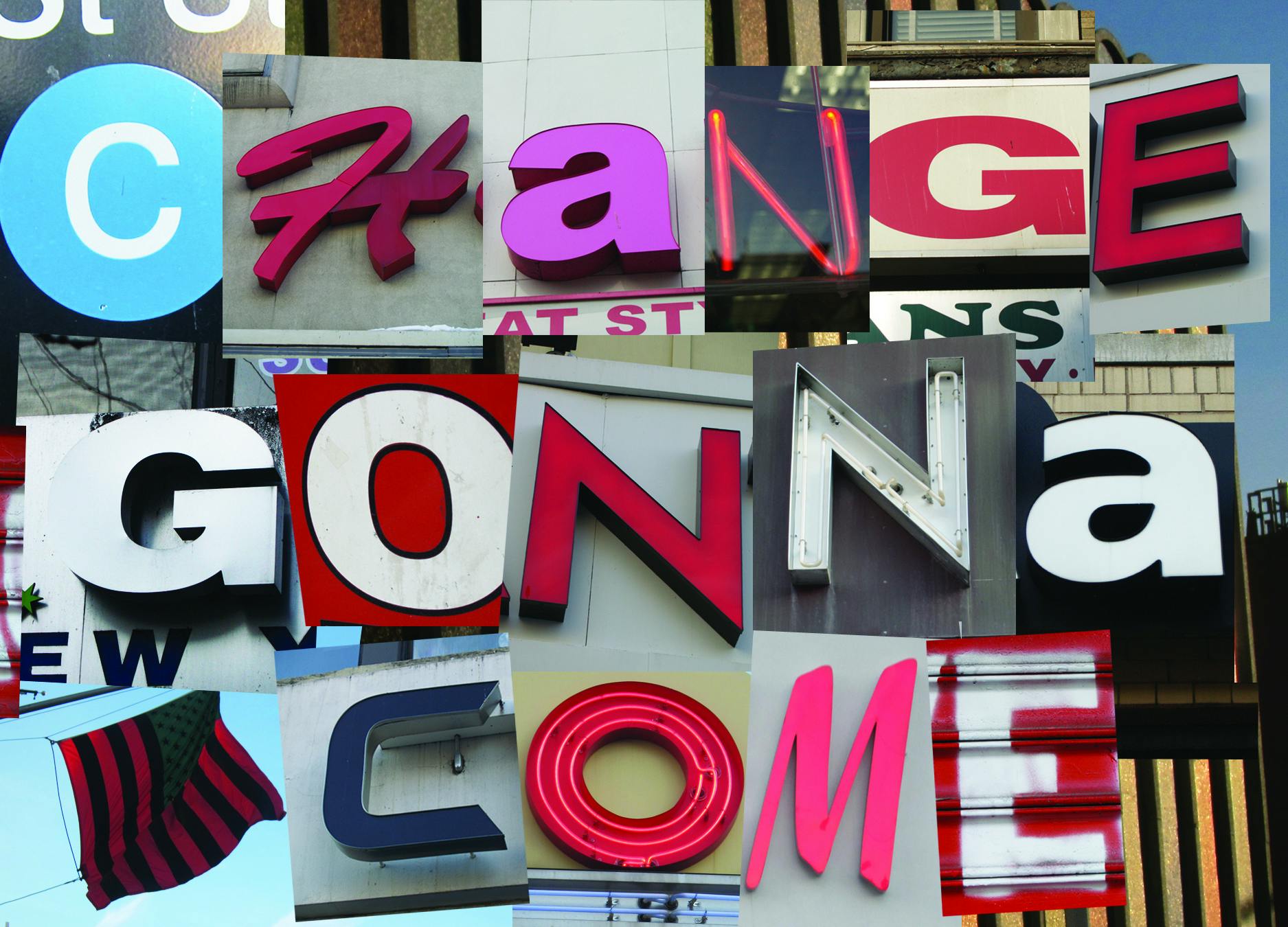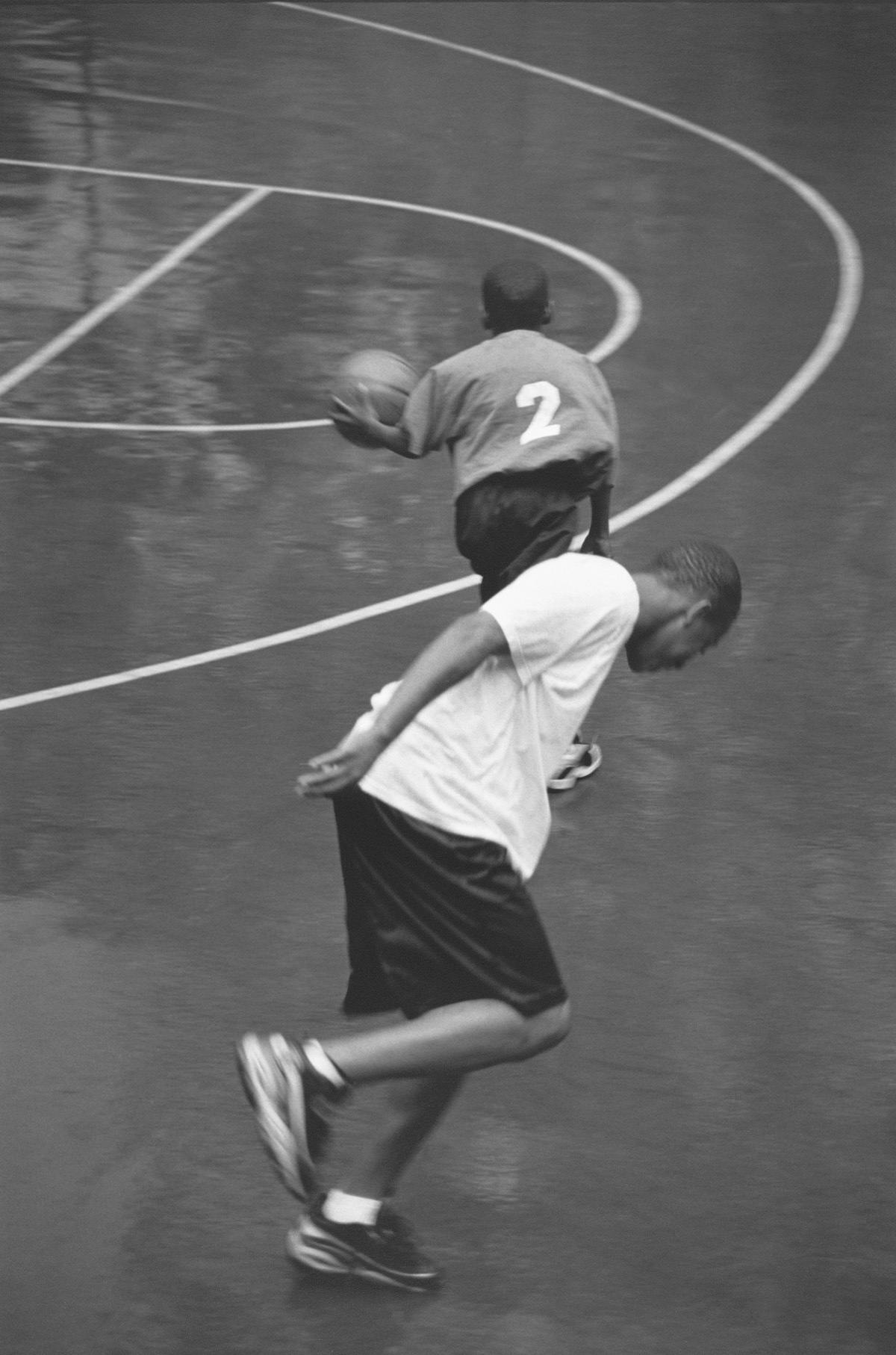Harlem Postcards Spring 2011
03.31-06.26.2011


Change gonna come is a tribute to the lyrics of a Sam Cooke song that refers to the hope and aspirations of the African-American community during the 1960s. It also frames the new and old businesses and entertainment venues that sustain the notion of change—cultural, economic, iconic. I find it intriguing that the song was likely performed by Cooke at the Apollo on 125th street. As someone who virtually grew up at the Schomburg Center on 135th Street and has been coming to the Studio Museum his entire life, I have countless recollections of walking down these streets. Harlem has once again become an epicenter of change. Striking to me now is the bold presence of new buildings, chain stores and high-end restaurants, and fewer street vendors. Also I see a marked change in the diversity of the residents of Harlem. This piece speaks to nostalgia and many complex thoughts of times—good and bad—that have come and gone, and continue to come again.

For The Studio Museum in Harlem I created a postcard that also serves as an invitation to a show outside of the Museum, along the Harlem River. On the appropriate dates, visitors can observe the work on the surface of the river after sundown. Much of my work deals with nighttime phenomena when the firmament is unobstructed. Ancient astronomers thought the moon contained oceans, which is why they named portions of it “mare.” Until recently, this theory was ignored, but then it was discovered that at one time in its four-billion-year history, the moon did, in fact, contain water. I use the camera in much of my work, so it’s worth noting that the moon is also associated with silver, a reflective metal that aids in the production of
photography.
Design by Stephanie Gonzalez-Turner

This image is an abstraction of the moon at its closest position to the Earth since 1993. Originally, I attempted to show the moon as accurately as possible by taking a photograph through a telescope on 125th Street. But after numerous attempts, I came to realize that we actually see the moon as a reflection, or perhaps projection, of ourselves. We see it as it exists in the imagination. I chose to include the Apollo Theater in the photograph to indicate my location with respect to the moon and to make the image distinct to Harlem. And there is a connection between the celestial body and the famous theater. Both the Apollo Theater and the Apollo moon missions have provided stages to which to aspire and feature the best humanity has to offer. Fitzgerald, Wonder, Armstrong and Aldrin, to name a few, took steps into the unknown, at the risk of great harm and potential failure.

Also known as The Rucker, this playground was founded in 1946 by Holcombe Rucker, a Harlem schoolteacher who wanted to use sports as a way to provide direction and teach life skills to thousands of boys and girls. An immediate success, it expanded to after-school programs and, in 1950, a pro division for professional basketball players anxious to assist Rucker. By the 1960s, The Rucker, located on 155th Street and Frederick Douglass Boulevard, was the place for top college and pro stars to prove their skills. Today Chris Rucker continues the legacy started by Holcombe years ago. While many consider The Rucker a place for building hoops skills, “its real success has been in building a community,” according to Chris. This photograph shows the rhythm, fluidity of form and expression of the human spirit that came from Holcombe Rucker’s commitment over half a century ago.
Harlem Postcards Spring 2011
03.31-06.26.2011


Change gonna come is a tribute to the lyrics of a Sam Cooke song that refers to the hope and aspirations of the African-American community during the 1960s. It also frames the new and old businesses and entertainment venues that sustain the notion of change—cultural, economic, iconic. I find it intriguing that the song was likely performed by Cooke at the Apollo on 125th street. As someone who virtually grew up at the Schomburg Center on 135th Street and has been coming to the Studio Museum his entire life, I have countless recollections of walking down these streets. Harlem has once again become an epicenter of change. Striking to me now is the bold presence of new buildings, chain stores and high-end restaurants, and fewer street vendors. Also I see a marked change in the diversity of the residents of Harlem. This piece speaks to nostalgia and many complex thoughts of times—good and bad—that have come and gone, and continue to come again.

For The Studio Museum in Harlem I created a postcard that also serves as an invitation to a show outside of the Museum, along the Harlem River. On the appropriate dates, visitors can observe the work on the surface of the river after sundown. Much of my work deals with nighttime phenomena when the firmament is unobstructed. Ancient astronomers thought the moon contained oceans, which is why they named portions of it “mare.” Until recently, this theory was ignored, but then it was discovered that at one time in its four-billion-year history, the moon did, in fact, contain water. I use the camera in much of my work, so it’s worth noting that the moon is also associated with silver, a reflective metal that aids in the production of
photography.
Design by Stephanie Gonzalez-Turner

This image is an abstraction of the moon at its closest position to the Earth since 1993. Originally, I attempted to show the moon as accurately as possible by taking a photograph through a telescope on 125th Street. But after numerous attempts, I came to realize that we actually see the moon as a reflection, or perhaps projection, of ourselves. We see it as it exists in the imagination. I chose to include the Apollo Theater in the photograph to indicate my location with respect to the moon and to make the image distinct to Harlem. And there is a connection between the celestial body and the famous theater. Both the Apollo Theater and the Apollo moon missions have provided stages to which to aspire and feature the best humanity has to offer. Fitzgerald, Wonder, Armstrong and Aldrin, to name a few, took steps into the unknown, at the risk of great harm and potential failure.

Also known as The Rucker, this playground was founded in 1946 by Holcombe Rucker, a Harlem schoolteacher who wanted to use sports as a way to provide direction and teach life skills to thousands of boys and girls. An immediate success, it expanded to after-school programs and, in 1950, a pro division for professional basketball players anxious to assist Rucker. By the 1960s, The Rucker, located on 155th Street and Frederick Douglass Boulevard, was the place for top college and pro stars to prove their skills. Today Chris Rucker continues the legacy started by Holcombe years ago. While many consider The Rucker a place for building hoops skills, “its real success has been in building a community,” according to Chris. This photograph shows the rhythm, fluidity of form and expression of the human spirit that came from Holcombe Rucker’s commitment over half a century ago.